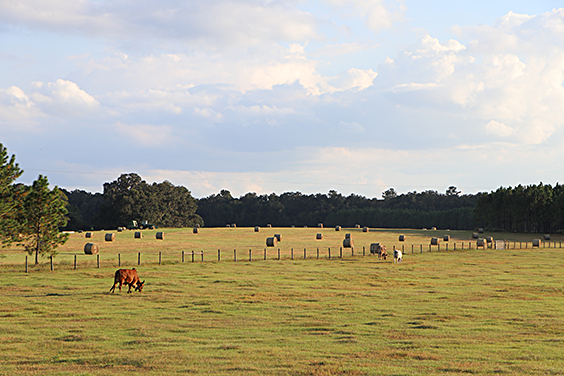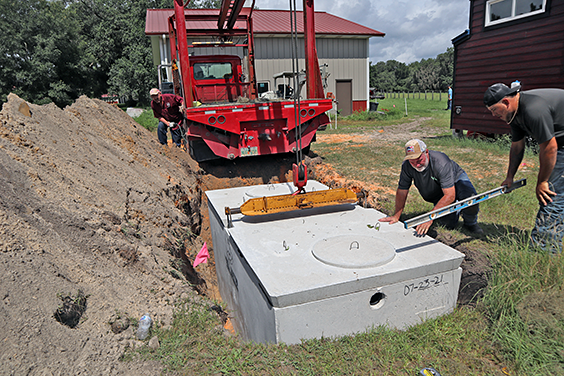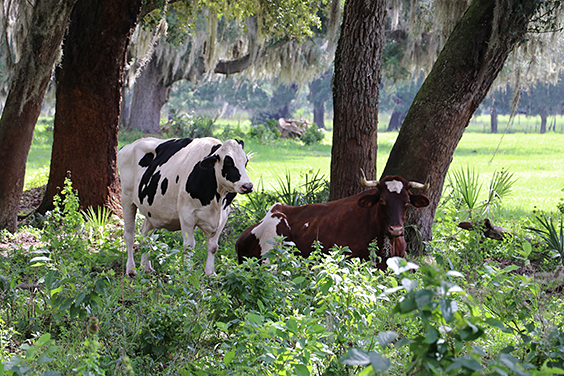- ISCOWP E-newsletters
Blackshirt.construction.BeefXDairy Vegetarians may think they are morally and ethically doing well by not eating meat. It is true ...

Madhava is our oldest (almost 15 years old) and largest ox (six feet at the shoulder). He has a horn that keeps growing into his face, and consequently, we needed to trim it two times. The second time we trimmed his horn was the most successful due to the help of Dr. Gemma Cock. Dr. Gemma brought a Gigli wire used by veterinarians to cut swine horns which proved effective. We thank Dr. Gemma (our neighbor), Keshav Motwani, and Balaji Dove, who filmed the procedure. Miss Gemma is a large animal medicine resident at UF College of Veterinary Medicine. Thanks, everyone, especially Madhava, for behaving so well during the procedure.
ISCOWP News
Thanks to your generous support ISCOWP has met the Matching Gift Challenge of $25,000. We are humbled and awed by your support. Due to meeting the Challenge, ISCOWP has sufficient hay for the winter and enough nutritional buckets and fly predators for a year. Thank you! Thank you! Now, we are honored with another Matching Gift Challenge for $25,000 to be met by the end of the year. As of the publishing of this e-newsletter, we have received $6,020.40 towards the second Challenge.

Tiny House Project
Our goal is to finish the Tiny House Project by the end of the year. Another staff member living at the sanctuary would be a big help to the development of ISCOWP. Also, many of you asked about coming for a few days to serve the cows. To facilitate these two needs, we have purchased two tiny houses equipped with their own bathrooms and kitchens. Before we can utilize the tiny houses, we need to finish the plumbing and landscaping. We bought one of the tiny houses secondhand, and it needs its sides, roof, door, and some wiring replaced. The other house we bought new needs a custom bench/cabinet built. We figure about $25,000 is needed to complete the project.
Today is the first day of Karthik, the holiest month of the year to Vaishnava Hindus, with the first five days being very auspicious. During this month, many Krishna childhood pastimes took place. Therefore, any act of charity pleasing to Krishna will be spiritually reciprocated abundantly at this time. Please help us complete this project and meet the second Matching Gift Challenge by donating today!

About Cows
“The term “cognitive bias” describes the effect of negative emotions or positive emotions on cognitive decision-making; when it influences human decision-making, we often refer to cognitive bias as either “pessimism” or “optimism.” Both human and nonhuman animals who have recently experienced a negative emotion may be less likely to take on a new challenge or perform well on a task, for example. Cows, too, experience cognitive bias, a finding that provides additional evidence for the complex interplay between a cow’s emotional experiences and her performance on tasks.
For example, one study showed that young calves were reluctant to approach a screen displaying ambiguous colors for at least 24 hours after they had been “dis-budded” (the term for the removal of a calf’s horn bud without anesthesia) with a hot iron. Even after the intense pain associated with the procedure had abated, the calves’ negative emotions persisted; this “pessimism” affected their engagement with a cognitive task.42 “ The Someone Project
About the Meat and Dairy Industries

Did you know that dairy cows are supposed to have horns if left to mature naturally? Disbudding is a standard horn removing method of a calf’s horns in the dairy industry. Paraphrased from Dehorning.com, “Disbudding involves the removal of horn-producing cells in calves less than two months of age. At this stage, horn buds are still free-floating and not yet attached to the skull’s frontal bone. Disbudding by caustic paste or hot iron destroys horn-producing cells in the horn bud. The dairy can also remove the horn buds using a knife or tube/cup/spoon. Disbudding is the preferred method of horn removal by the American Veterinary Medical Association and recommends the procedure performed at the earliest age practicable.”
Disbudding is more humane than dehorning. However, due to the cruel manipulation of cows in the dairy industry, controlling the cows would become dangerous if the cows had horns which they could use to protect themselves and protest their treatment. Therefore, the safety of the dairy workers is the reason for disbudding or dehorning.

7016 SE 92 Terrace
Gainesville, FL 32641 USA
Phone: 352-792-6777
E-mail ISCOWP
Keep up with the latest news from ISCOWP. Sign up with your e-mail address to receive updates.
"*" indicates required fields
© 2023 This is the only official site of The International Society for Cow Protection, Inc. (ISCOWP) incorporated in 1990, located only in Gainesville, FL, USA. ISCOWP and The Lotus/Cow symbol are registered service marks of The International Society for Cow Protection, Inc. Website content can not be reproduced without permission.